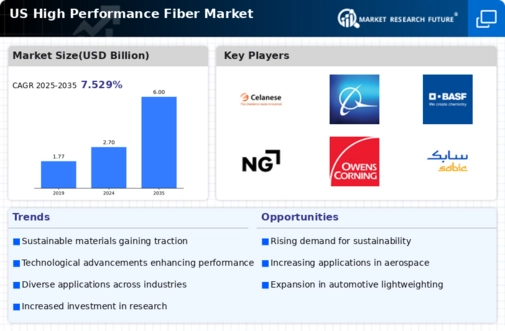The high performance-fiber market is characterized by a dynamic competitive landscape, driven by innovation, sustainability, and technological advancements. Key players such as DuPont (US), Honeywell International (US), and Toray Industries (JP) are at the forefront, each adopting distinct strategies to enhance their market positioning. DuPont (US) focuses on developing advanced materials that cater to diverse applications, emphasizing sustainability and performance. Honeywell International (US) leverages its technological expertise to innovate in fiber production, while Toray Industries (JP) is expanding its global footprint through strategic partnerships and acquisitions, thereby enhancing its competitive edge.
The market structure appears moderately fragmented, with several players vying for market share. Companies are increasingly localizing manufacturing to optimize supply chains and reduce lead times. This tactic not only enhances operational efficiency but also aligns with the growing demand for sustainable practices. The collective influence of these key players shapes a competitive environment where innovation and responsiveness to market needs are paramount.
In October 2025, DuPont (US) announced a significant investment in a new manufacturing facility aimed at producing bio-based high performance fibers. This strategic move is expected to bolster its production capacity and cater to the rising demand for sustainable materials. The investment underscores DuPont's commitment to sustainability and positions the company to capitalize on the growing trend towards eco-friendly products.
In September 2025, Honeywell International (US) launched a new line of high performance fibers designed for aerospace applications, integrating advanced technology to enhance performance and safety. This initiative not only strengthens Honeywell's product portfolio but also reflects its focus on innovation in high-stakes industries. The introduction of these fibers is likely to attract significant interest from aerospace manufacturers, further solidifying Honeywell's market position.
In August 2025, Toray Industries (JP) entered into a strategic partnership with a leading automotive manufacturer to develop lightweight, high performance fibers for electric vehicles. This collaboration is indicative of Toray's proactive approach to addressing the evolving needs of the automotive sector, particularly in the context of sustainability and efficiency. By aligning with key industry players, Toray is well-positioned to leverage emerging opportunities in the high performance-fiber market.
As of November 2025, current trends indicate a pronounced shift towards digitalization, sustainability, and the integration of AI in production processes. Strategic alliances are increasingly shaping the competitive landscape, enabling companies to pool resources and expertise. The focus appears to be shifting from price-based competition to differentiation through innovation, technology, and supply chain reliability. This evolution suggests that companies that prioritize these aspects will likely emerge as leaders in the high performance-fiber market.





















Leave a Comment